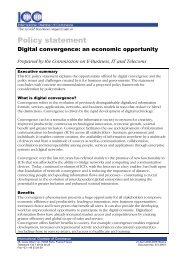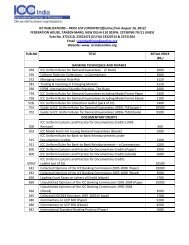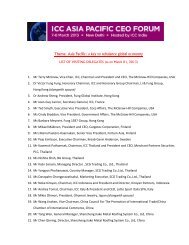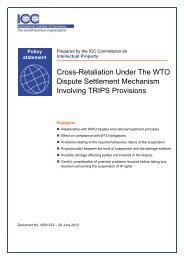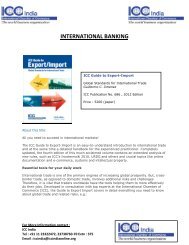2013 - ICC India
2013 - ICC India
2013 - ICC India
- No tags were found...
Create successful ePaper yourself
Turn your PDF publications into a flip-book with our unique Google optimized e-Paper software.
<strong>ICC</strong> BANKING COMMISSION | <strong>2013</strong> GLOBAL RISKS TRADE FINANCE | APPENDIX B 37Basel I – this was an initial step in 1988 to improve the consistency inregulations governing the capital adequacy of banks and to improve theamount of capital held by banks. Whilst initially focused on credit risk,this was subsequently amended in 1996 to further cover market risk 50through the Market Risk Amendment to the Capital Accord 51 . This providedbanks with a choice of using simple rules or banks’ own internal models toestimate the capital to hold against market risk exposures.Basel II – this was a new accord developed with significantly more risksensitiverequirements. It recognised that Basel I did not adequately reflectthe underlying credit risks banks were facing and that other risks (such asoperational risk) or products (such as securitisations) were not includedwithin the Basel I accord. It also noted the growing use of credit riskrating approaches amongst banks. This accord was agreed in 2004 withimplementation intended to start at the end of 2006 or 2007 (dependingupon the approach being adopted).Basel 2.5 – in response to some of the issues with Basel II identified duringthe recent crisis, the Basel committee issued a package of documents tostrengthen the Basel II accord, addressing in particular certain complexsecuritisation positions, off balance sheet vehicles and trading bookexposures. This package of documents (commonly referred to as Basel 2.5,but strictly speaking improvements to the existing Basel II standards), wasissued in July 2009 and came into force from December 2010.Basel III – whilst the package of documents referred to as Basel 2.5addressed a number of issues highlighted by the crisis, other issues such asthe treatment of liquidity risk or the quality of capital used to ensure capitaladequacy took longer to formulate and agree. At the end of 2009, the Baselcommittee issued the Basel III documents with the intention that they wouldbe phased in between <strong>2013</strong> and 2019.Given the collaborative nature of the Basel committee and the range ofcountries involved, there have always been a number of areas within theframeworks where discretion is left to supervisors. This has been done inorder to reflect differences in local markets and practices, but potentiallyruns the risk that capital requirements do not converge as much as hopedand that banks do not operate on a “level playing field”. Although theuse of national discretion is beneficial, this may undermine one of theoriginal fundamental objectives of the capital accords, which was “thatthe framework should be fair and have a high degree of consistency in itsapplication to banks in different countries with a view to diminishing anexisting source of competitive inequality among international banks.” 52Furthermore, the accords are not strictly speaking legally binding (as theyare agreements amongst international regulators) and need to be enactedinto law in each country before they become binding 53 . This has a fewimplications:■■■■The speed of adoption varies across countries. For example, someemerging markets are not yet covered by the Basel II rules, while inthe EU, rules enacting Basel III are still being negotiated at the time ofwriting. The extent of adoption of the accords varies across countrieswith, for example, the US only requiring compliance with their version ofBasel II for the largest firms.As the accords go through the legislative process politicians may makeamendments so that the final implementation may not always follow thestrict letter of the Basel standards.



